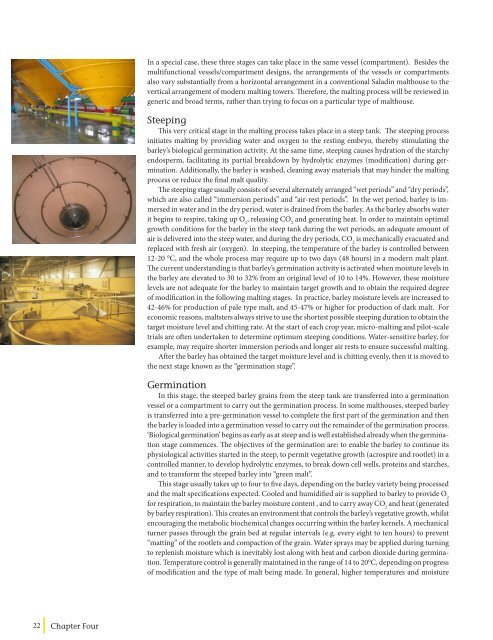MALTING QUALITY TRAITS - Canadian Malting Barley Technical ...
MALTING QUALITY TRAITS - Canadian Malting Barley Technical ...
MALTING QUALITY TRAITS - Canadian Malting Barley Technical ...
Create successful ePaper yourself
Turn your PDF publications into a flip-book with our unique Google optimized e-Paper software.
22<br />
Chapter Four<br />
In a special case, these three stages can take place in the same vessel (compartment). Besides the<br />
multifunctional vessels/compartment designs, the arrangements of the vessels or compartments<br />
also vary substantially from a horizontal arrangement in a conventional Saladin malthouse to the<br />
vertical arrangement of modern malting towers. Therefore, the malting process will be reviewed in<br />
generic and broad terms, rather than trying to focus on a particular type of malthouse.<br />
Steeping<br />
This very critical stage in the malting process takes place in a steep tank. The steeping process<br />
initiates malting by providing water and oxygen to the resting embryo, thereby stimulating the<br />
barley’s biological germination activity. At the same time, steeping causes hydration of the starchy<br />
endosperm, facilitating its partial breakdown by hydrolytic enzymes (modification) during germination.<br />
Additionally, the barley is washed, cleaning away materials that may hinder the malting<br />
process or reduce the final malt quality.<br />
The steeping stage usually consists of several alternately arranged “wet periods” and “dry periods”,<br />
which are also called “immersion periods” and “air-rest periods”. In the wet period, barley is immersed<br />
in water and in the dry period, water is drained from the barley. As the barley absorbs water<br />
it begins to respire, taking up O 2 , releasing CO 2 and generating heat. In order to maintain optimal<br />
growth conditions for the barley in the steep tank during the wet periods, an adequate amount of<br />
air is delivered into the steep water, and during the dry periods, CO 2 is mechanically evacuated and<br />
replaced with fresh air (oxygen). In steeping, the temperature of the barley is controlled between<br />
12-20 °C, and the whole process may require up to two days (48 hours) in a modern malt plant.<br />
The current understanding is that barley’s germination activity is activated when moisture levels in<br />
the barley are elevated to 30 to 32% from an original level of 10 to 14%. However, these moisture<br />
levels are not adequate for the barley to maintain target growth and to obtain the required degree<br />
of modification in the following malting stages. In practice, barley moisture levels are increased to<br />
42-46% for production of pale type malt, and 45-47% or higher for production of dark malt. For<br />
economic reasons, maltsters always strive to use the shortest possible steeping duration to obtain the<br />
target moisture level and chitting rate. At the start of each crop year, micro-malting and pilot-scale<br />
trials are often undertaken to determine optimum steeping conditions. Water-sensitive barley, for<br />
example, may require shorter immersion periods and longer air rests to ensure successful malting.<br />
After the barley has obtained the target moisture level and is chitting evenly, then it is moved to<br />
the next stage known as the “germination stage”.<br />
Germination<br />
In this stage, the steeped barley grains from the steep tank are transferred into a germination<br />
vessel or a compartment to carry out the germination process. In some malthouses, steeped barley<br />
is transferred into a pre-germination vessel to complete the first part of the germination and then<br />
the barley is loaded into a germination vessel to carry out the remainder of the germination process.<br />
‘Biological germination’ begins as early as at steep and is well established already when the germination<br />
stage commences. The objectives of the germination are: to enable the barley to continue its<br />
physiological activities started in the steep, to permit vegetative growth (acrospire and rootlet) in a<br />
controlled manner, to develop hydrolytic enzymes, to break down cell wells, proteins and starches,<br />
and to transform the steeped barley into “green malt”.<br />
This stage usually takes up to four to five days, depending on the barley variety being processed<br />
and the malt specifications expected. Cooled and humidified air is supplied to barley to provide O 2<br />
for respiration, to maintain the barley moisture content , and to carry away CO 2 and heat (generated<br />
by barley respiration). This creates an environment that controls the barley’s vegetative growth, whilst<br />
encouraging the metabolic biochemical changes occurring within the barley kernels. A mechanical<br />
turner passes through the grain bed at regular intervals (e.g. every eight to ten hours) to prevent<br />
“matting” of the rootlets and compaction of the grain. Water sprays may be applied during turning<br />
to replenish moisture which is inevitably lost along with heat and carbon dioxide during germination.<br />
Temperature control is generally maintained in the range of 14 to 20°C, depending on progress<br />
of modification and the type of malt being made. In general, higher temperatures and moisture


